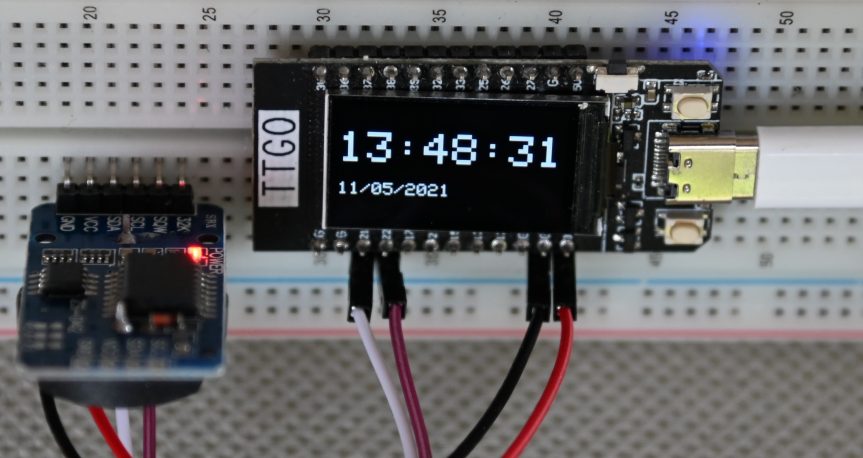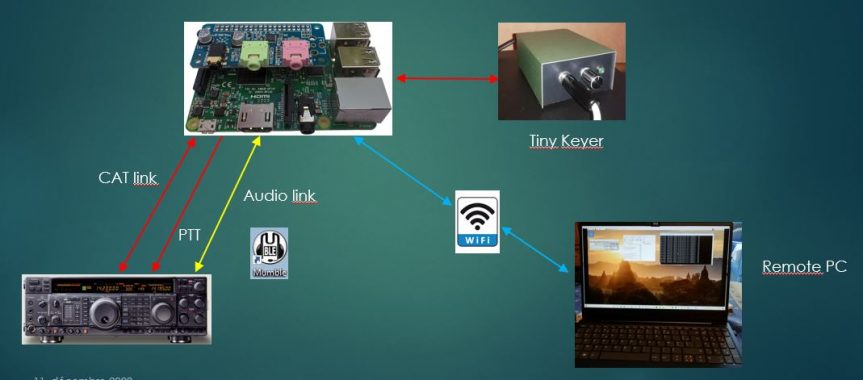This article describes an open-source solution to implement a FTdx101d remote station with a view of the FTdx101 screen. This solution is directly applicable to the FTdx101 MP, FTdx10 and FT-710 choosing the right radio model in the CAT software. This solution can be implemented on the home LAN (WiFi or Ethernet) or through the Internet.
Continue reading “Remote access to an FTdx101 with a remote view of its screen”FTdx101 CAT with DXLab Commander and SDRuno
The SDRuno software allows to interface the CAT link of a transceiver using the Omni-Rig software to control the frequency and mode in both directions. This software also provides frequency and mode synchronization with another CAT software such as DXLab Commander for example, using virtual COM ports by emulating a Kenwood CAT. This article presents such a configuration with the FTdx101 and another configuration without the Kenwood interface whose advantages will be presented.
Continue reading “FTdx101 CAT with DXLab Commander and SDRuno”Customizing DXLab Commander for the FTdx101
To have an easy access to some FTdx101 controls that are not directly accessible or to control the FTdx101 from the PC I used the customization possibility offered by the Commander software of the DXLab suite.
Continue reading “Customizing DXLab Commander for the FTdx101”A date-time display on ESP32 using a DS3231 Real-Time Clock
In ham-radio digital mode transmissions some protocols (WSPR, FT8, …) require a synchronization of the order of one second between all stations.
To have an accurate time on ESP32 there are several solutions:
– the connection to an NTP server,
– the connection to a GPS,
– the use of a saved real-time clock,
– a combination of several methods.
The first two solutions involve either being connected to a network (WiFi, …) or to be able to receive GPS signals which is not always possible.
This article presents the realization of a date-time display on an ESP32 TTGO T-Display using a saved DS3231 real-time clock.
Continue reading “A date-time display on ESP32 using a DS3231 Real-Time Clock”Raspberry Pi
Bluetooth serial link with an HC05
This article describes the solution adopted to set up a Bluetooth serial link between a Raspberry Pi and an HC05 module. This allows me to connect the FT857 radio via Bluetooth to the Raspberry Pi.

Bluetooth serial link with an HC05″
CAT FT-857D from a web browser Technical aspects
The control of a radio station is usually done by an application installed on a target machine, this application being often developed specifically for an operating system (Windows, Unix, …). After a description of the functional aspects in a previous article, this video presents the technical aspects of the implementation of the FT-857D CAT in a web browser.
The presentation of the technical aspects in pdf.
Source code : https://github.com/Phil-f6czv/FT857-Web-browser-CAT-ESP32
FT-1000 Mark V Remote Station with a Raspberry Pi
There are currently proven solutions using a Raspberry Pi to operate a remote radio station whether industrial or open source; those include MFJ’s RIGPI solution or RemoteQTH’s Open Source developments.
Owning a Raspberry Pi 3B with a sound card, I wanted to make a remote control prototype of my FT-1000 Mark V Field that does not require any developments and uses only open source software, free or low cost softwares. I call it a prototype because an operational solution must take into account the remote radio ON/OFF, the reset of the Raspberry Pi, computer security (anti-intrusion, …) and possible remote switches of devices (amp, antennas, …)
I already used my Raspberry Pi to run WSJT-X in FT8 remotely controlled by my PC using VNC Viewer. So I looked for a software solution to transmit the sound between the radio and the PC and a simple and user-friendly solution to control the radio:
– for the sound I chose the Mumble suite that has the shortest latency, the other solutions leading to latency of more than a second,
– for the the radio control I chose flrig that supports 60 different radios and that has a user-friendly interface (GRIG and rigctl were also tested).
The solution described was successfully used to make phone QSOs with the Yaesu FT-1000 Mark V Field on a WiFi LAN. It also works with a Yaesu FT-857D.
I also tested a second solution that uses the usual software suites on the PC (DXLab, HAMRadio Deluxe, N1MM) to control the radio using COM TCP ports. It will be described in another presentation.
This page contains a video presentation of the first solution and a file providing all the commands to install the softwares.
Softwares installation document
73
Philippe – F6CZV
CW Skimmer and SDRPlay
CW Skimmer is a software that allows to:
– decode simultaneously on a frequency range:
– either the stations calls,
– or the transmission content.
– display the Morse code (dots/dashes) of a signal.
– generate spots to a local or remote server.
– feed a spectrum window of the frequency range for example the Spectrum window of N1MM.
In input CW Skimmer uses either a 3 KHz audio stream or an IQ stream from an SDR up to 192kHz of bandwidth. It is in the latter case that the use is most interesting. In our case both interfaces were tested interfacing the SDRuno software.
There is also a server version of Skimmer without MMI that can simultaneously decode the calls on 7 amateur bands (if the associated SDR allows that) and provide the corresponding spots.
The attached presentation describes the configurations used for the tests I performed as well as a findings on the use of that software.
FT-857D CAT from a web browser
Functional aspects
A hamradio station remote control is usually done by an application installed on a dedicated machine, this application being often developed according to an operating system (Windows, Unix, …). This video shows a FT-857D remote control using an application developed on a web browser and therefore independent of the system. The web server is an ESP32 TTGO micro-controller board connected to the FT-857D.
The developments are based on those described in the article on FT-857D parameters display on an ESP32 board.
The video presents the developments functional aspects.
The video is in French but is subtitled in English.
YAESU FT-857D parameters display on a TTGO-T-Display
The work was to port the FT-857D CAT library and the corresponding display application on the ESP32 T-Display. This software was originally developed on an Arduino Nano (see article) The goal was to have a platform of the same size as the Arduino Nano but with in addition to the serial link, an on-board WiFi and Bluetooth.
Continue reading “YAESU FT-857D parameters display on a TTGO-T-Display”



